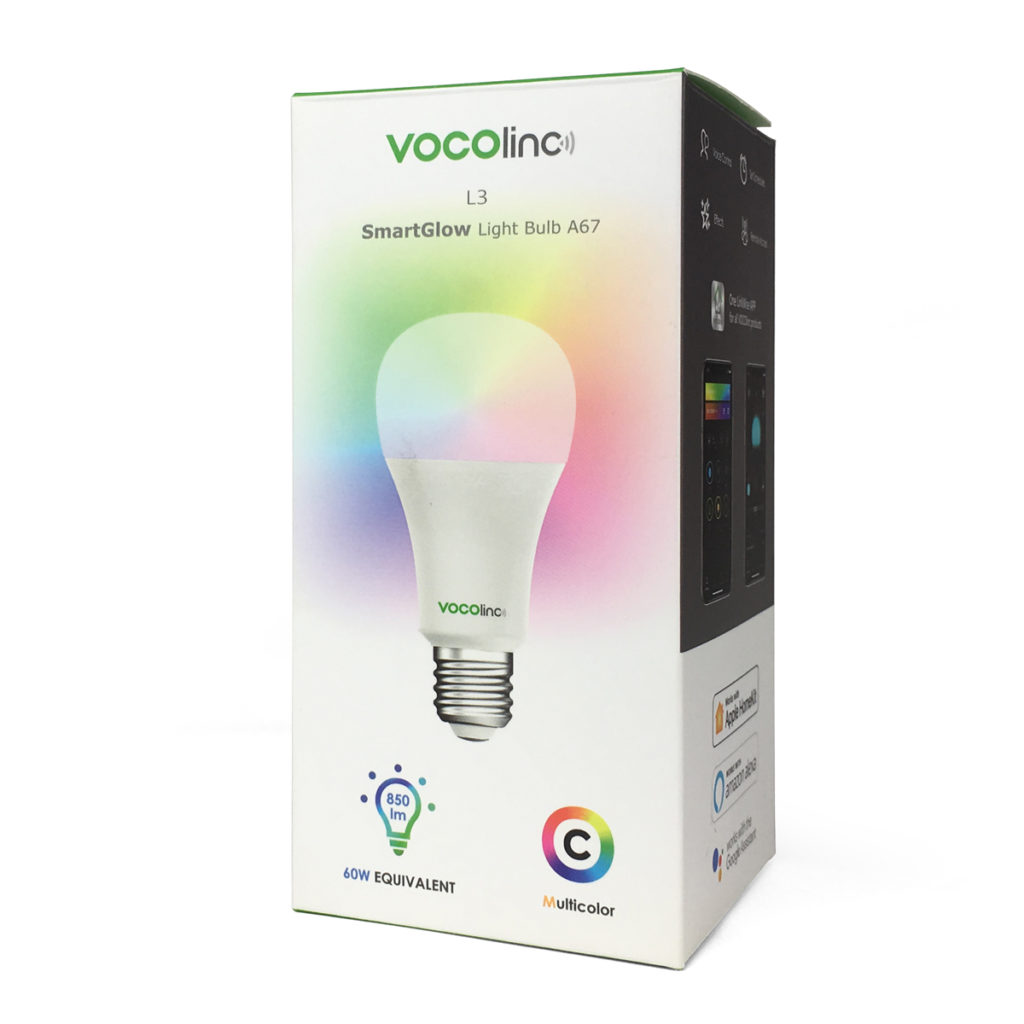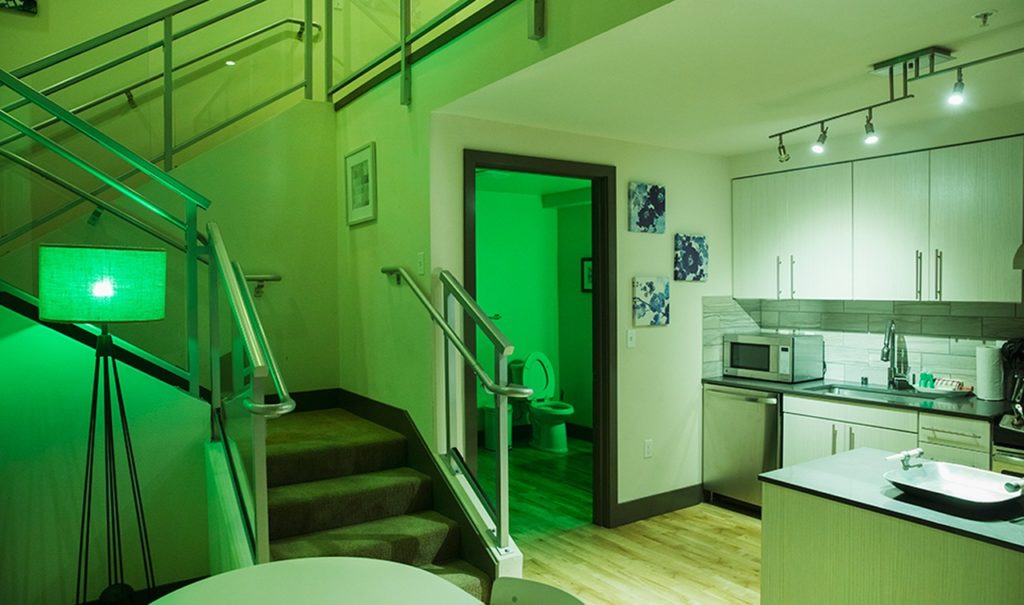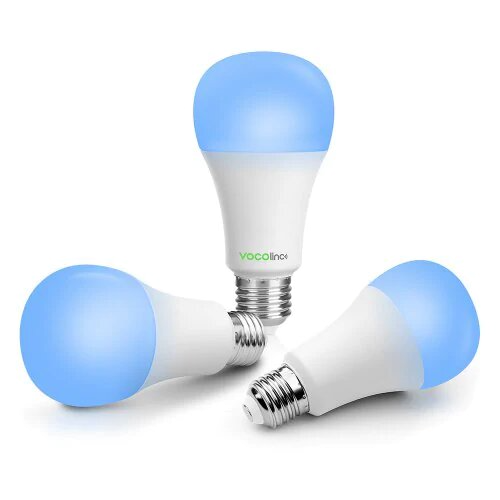Lighting is among one of the easiest ways to get started with home automation and it’s for good reason. We all need some sort of light source in our homes. The big debate is usually between switches and smart bulbs. Within this debate, there are micro-debates regarding to hub or not to hub and there are advantages and disadvantages to both. Personally, I do not mind a hub and having a hub usually means that the products use Zigbee which is ultra-responsive and very reliable or some other proprietary protocol which tend to be very reliable and responsive as well. In this post, we’ll take a look at VOCOlinc’s recently updated WiFi light bulb, compare it a bit to its predecessor, and hopefully help you make a more informed buying decision.
A review unit was provided to myHomeKithome for the purpose of this review, but no compensation was received nor was the content reviewed before publishing. All thoughts expressed are purely those of my own.
Features
- full 16 million color range
- 2,200 – 7,000 K tunable white range
- 850 lumens (60W incandescent equivalent)
- Works with Apple HomeKit, Google Assistant, and Amazon Alexa

Need to Knows
- Connects over 2.4 gHz WiFi band
- A21 bulb type
- Maximum 9.5W energy consumption
Pros
In terms of design, there’s not a whole lot to talk about here. It has essentially the same form factor as a standard LED bulb and the same as the previous generation L1 model. One thing we did notice though, is that VOCOlinc is obviously making a focused effort to reduce packing and although the size of the box and the packaging material have reduced, there is seemingly no compromise in the safety of the product while in transport.
The brightness and color saturation of the L3 SmartGlow bulb is impressive and is a massive improvement of the first gen version. In fact comparing it to a Phillips Hue Color and White Ambience bulb, not only do the specs Lin up on paper, visually we weren’t able to detect any noticeable differences in terms of color saturation nor brightness. While not quite on par with LIFX, and not many can hold a candle to LIFX (pun definitely intended), the SmartGlow bulb is Is a reasonable option as a primary lighting source for a room.
This may be a result of the manufacturing process or it may have been intentional, but when switching off the L3, the light fades out as opposed to going into instant darkness. It might not seem like a huge deal, but it’s a nice subtle touch that somehow adds a calming effect to your lighting setup.
Cons
When compared to the L1 as we mentioned above, the L3 is noticeably brighter and might even be considered as a primary light source for a room. This being said, I still feel it could be a bit brighter. This is a limitation of the manufacturing process at this point. Sure, LED bulbs can be brighter, but then the cost starts to get away from us; enter LIFX. It seems that VOCOlinc is looking to strike the balance between cost and features and I do think they’ve done a pretty remarkable job, especially if we compare it to the bigger players in the smart lighting arena. This not withstanding, I want more light!
We’ve not touched on this a lot, but let’s consider the use of a WiFi smart light bulb in general. First, the switch that the light source is connected to must always be in an on position in order for the “smart” features of the bulb to function. There is almost nothing more annoying that having an automation or scene fail because somebody turned of the switch. As a result of the switch always being powered on and the bulb being smart, it does draw a very small amount of power, about 1W. While this might not be a lot, when you start crunching numbers of the 25,000 hour life of a conventional LED bulb, it can add up. The second issue is probably the more obvious one. If your WiFi goes out, you’re left only the on/off functionality provided by the switch. What a sad world it is. Finally, we have to consider control. While this harkens back to our first issue with WIFi bulbs, it’s worth exploring a little more. Since we want the light to always be connected to power, but not necessarily on, we need some way to control it. A smartphone words great, but always having your phone on you while trouncing about the house. Fortunately, HomeKit does provide a slew of wireless switch and sensor options in order to control the light and if we analyze our habits well enough, we can use automations to help control the light. As you can see, though WIFi connectivity provides quite a bit of added benefits, it also causes some issues you wouldn’t otherwise have.
Another downside to using WiFi, or Bluetooth, as a means for connecting an accessory is range. While Zigbee and other protocols create a mesh network by where the connection is strung from device to device creating lots of different paths for speedy communication, WiFi and Bluetooth accessories rely on their proximity to a host device. Thankfully for devices that c. connect to WiFi, this issue can be remedied with a range extender or upgrading to a WiFi mesh system depending on your needs. This is definitely something you’ll want to keep in mind not just with the VOCOlinc SmartGlow products, but with any HomeKit accessory that uses WiFi as its means of connection.
The App
I’ve stated on numerous occasions at this point that I use different apps for different actions related to HomeKit, but that Apple’s Home app is my preferred interface for on-the-fly interactions with my HomeKit home due to its ubiquity across devices, integration into Control Center, and simple interface. For automations, I tend to use either the Eve for HomeKit app or Home 3 as these two apps offer a much more robust and customizable set of services and functionality that Apple’s Home app just doesn’t provide. Very sparingly, however, do I use any other HomeKit apps for tings other than firmware updates with the exception of the LinkWise app.
Admittedly, I’m not the biggest fan of the aesthetics of the app, in particular the color scheme. A lot of times it can be misleading and even down right confusing in terms of what different colors mean. In VOCOlinc’s defense in this regard, they respond really well to feedback and release regular updates to try to fix these issue. The layout of the app is interesting and doesn’t bother me much at all. I also like that as a HomeKit user, I am not required to sign up for yet another account unlike some other manufacturers’ apps. However, if you plan on using one of those other inferior digital assistant smart speaker thingamajigs, you may have to concede.
As far as features that the LinkWise app offers that are not available via Apple’s Home app and/or HomeKit, we get access to some dynamic lighting effects and scenes. In fact, the L3 has a couple of lighting effects that the L1 doesn’t have. Both the L1 and L3 bulbs share the Breathe, Blink, and Flow lighting effects, but the Flicker and Candle effects are reserved for the SmartGlow bulb.
Final Thoughts
As the connected home continues to gain in popularity, we are starting to see prices of products drop allowing even more access to devices that may have previously been out of reach or just not justifiable for many consumers and LED and smart lighting is a clear example of this. Whether you decide on switches or bulbs or a combination of the two as your chosen smart lighting solution, WiFi bulbs play a compelling role whether as a primary light source or as accent lighting, though I tend to lean toward the latter.
VOCOlinc’s initial foray into the colored smart bulb market was a fair contender with the L1 bulb at least in terms of accent lighting as its luminous output was just a bit too low in my opinion to be considered for a primary light source. The L3 SmartGlow bulb amps up the lumens and even manages to improve a bit on the color saturation front putting it squarely in competition with the likes of Phillips Hue in terms of the bulb itself.
If you’re trying to make a choice between the L1 or the L3, the L3 is the way to go. Sure it’s a bit more expensive, but the price increase is made up for with more vivid colors and elevated brightness. Remember, you’ll have this bulb for quite a long time so spend a little extra money now to get a stronger product throughout its ~25,000 lifespan. Are you Team Switch or Bulb, or a combo, when it comes to smart lighting for your home? Tell us why in the comments. Also, come hang out and share the latest gossip in the HomeKit world on social media @myhomekithome.
Links & Resources
Learn more about VOCOlinc’s entire lineup of smart lighting and other HomeKit-compatible smart home gear at https://www.vocolinc.com
We use income-earning affiliate links.
We may receive a small commission on purchases made using links on this page at no extra cost to you.




